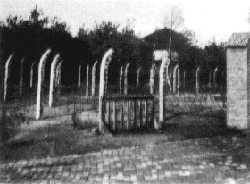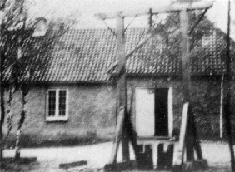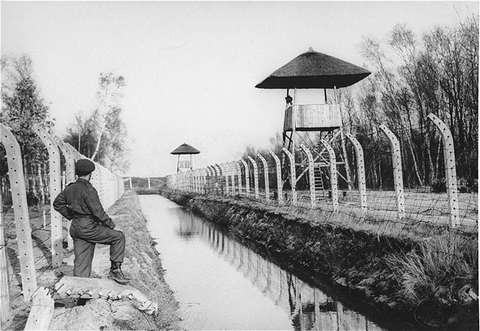Vught Concentration Camp (Holland)

One of the rare photos of Vught
Note: Thanks so much to Kathy Bjegovich and her father Norman Turner, Canadian WW2 veteran and liberator of Vught concentration camp for the informations they kindly sent me concerning the liberation of the camp. This page has been updated on July 27th, 1998.
Officially, in occupied Holland, only Vught was considered by the Nazis as a concentration camp (Konzentrationslager Herzogenbusch). The first prisoners arrived in Vught on January 13th, 1943. They arrived from Amersfoort and were in a pitiful condition. The first Jewish prisoners arrived on January 16th, 1943. The first commander of the camp was an SS captain named Karl Chmilewski. This SS Officer was well known for the barbaric atrocities he had committed at the camp of Gusen, an sub-camp of Mauthausen. (Mauthausen had a reputation as one of the most brutal Nazi camps). Later, the commanders of the camp were SS officer Grunewald (October 1943) and SS officer Huttig (February 1944).

The Crematories
The electric fences and the look-out towers. Originally, Vught was divided into two sections: the first one (Judendurchgangslager - JDL) was designed to hold the Jewish prisoners before their transit to Germany the transfers were done in two transports: from Vught to Westerbock then from Westerbock to the extermination camps. The pending transfer of Jewish prisoners to Westerbock never created panic: many of the Jews thought that they would stay permanently in Westerbock. They didn't know that Westerbock was just a "waiting room" before their extermination.
The second section of Vught was designed as a security camp (Schutzhaftlager). This section received all the Dutch and Belgian political prisoners, men and women. The guards were exclusively SS. The food was nearly nonexistent : warm water with some carrots or sauerkraut floating on the surface. The SS guards tortured the prisoners with incredible cruelty beating them to death (several prisoners were brutalized with a club wrapped with barbed wire). The SS often provoked their dogs to attack prisoners and there are several testimonies of horrible wounds, including to genitals. Hundreds of Dutch and Belgian prisoners were executed by shooting in a place called "De Ijzeren Man", located +-900 meters from the camp.

The gallows. There was another gallows in the bunker.
The gallows. There was another gallows in the bunker. Two other sections were established in May and Augusts 1943: the "Frauenkonzentrationslager" (FKL) fro women and the "Polizeiliches Durchgangslager" (PDL) for prisoners in detention, mostly for a short period.
Like any other Nazi concentration camp, Vught had its own gallows and crematorium. In September 1943, the gallows was used for the executions of 20 Belgian prisoners. There were several convoy from Vught to the major camps located in Germany and Poland: i.e. in June 1943, hundreds of Jewish children were sent to Sobibor extermination camp. There were also transportation of Jews to death camps in November 1943 and June 1944. In July, as the Allied forces approached, the number of executions increased dramatically.
The 4th Canadian Armor Division, and the 96 Th Battery of the 5th Anti -Tank Division were the first in liberating Vught concentration Camp. The Canadians troops came over the hill right up to the wall fighting the Germans. The Germans were evacuation from the camp and left a rear guard action to fight the allies. They were fighting and running at the same time. As you entered the camp into a courtyard there were 500 bodies laying in a pile that these poor people were just executed that morning. They were just thrown in a pile. There were around 500-600 live prisoners left who had been set up for execution that afternoon, but, the Canadian's arrived instead so they were spared. The people were in the most horrible condition, starving to death, ill, and very badly mistreated. When the Canadian's arrived they were standing around in the courtyard. Not in any barracks just standing around while the fighting was going on. My father was one of the survivors. He would remain crippled for the rest of his life.

Watch towers in Vught
The former camp location is now occupied by a penitentiary. In April 1990, the National Monument Camp Vught was opened by H.M. Queen Beatrix. I visited the museum in July 1998 and it is a very moving place. The museum is open from April 1th through October 31th (10am - 17pm Tuesday - Saturday, 12pm - 17pm Sunday - Monday). The museum is located at Lunettenlaan 600, Vught, Holland. The entrance is free. There is also a permanent exhibition about the "Kamp Vught" in the "Vughts Historish Museum", Taalstraat 88a, Vught. The Museum board can be contacted via: National Monument Camp Vught Foundation, Postbus 47, 5260 AA Vught, Holland.
Vincent Châtel
Source: http://www.jewishgen.org/ForgottenCamps/Camps/MainCampsEng.html
| Badges of the Holocaust | Camp List | Holocaust Discussion Forum | Holocaust Memorium | Holocaust Timeline | Other Links |
Copyright©2003 Christian Churches of God
